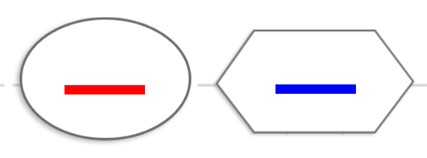MC2 subject + verb
You will need:
- Large oval and hexagon shapes and/or SHAPE CODING app
- Toys/small figures and action verb cards
- Check/teach vocabulary through acting out tasks. Ask the child to jump, run, laugh, smile, sit, stand. Select known verbs to use in sessions. >
- Introduce SHAPE CODING template: Introduce oval (WHO) and hexagon (WHAT DOING) shapes and lay them out in Subject + Verb order (as shown below).
 Show a toy figure doing something, e.g. a boy jumping. Stand the boy on the oval and either write jumping or stick a jumping action card on the hexagon. Say: “The boy is jumping”. Point to the correct shape as you speak. Say the sentence again, pick up the boy as you say “the boy”. Move him along to the hexagon as you say “is jumping” and then make the boy jump on the hexagon. Ask the child to act out the sentence. Ask: “Who is jumping?” and ”What is the boy doing?” to check the child knows which shape answers which question. Answer the WHO question with just “the boy” and the WHAT DOING question with just “jumping”. Do not say the whole sentence in answer to these questions as we want to make the link between the question and the short answers.
Note: Do not use pronouns at this language level; do not worry about verb endings or whether the child includes the or is. The child saying “boy jump” is fine at this stage. However, the adult should always use a full grammatical sentence, placing emphasis on the key words. If you want to put the is in a shape, you will have to introduce the diamond between the oval and hexagon, but do not focus on this at this stage.
Ask the child to pick another toy figure. Add this figure’s name (e.g. Ted) to the oval. Keep the verb the same. Ask the child to show you what Ted is doing, e.g. jumping. Write jumping or stick a symbol of jumping on the hexagon. Say: “Ted is jumping”. Ask: “Who is jumping?” and ”What is Ted doing?” to check the child knows which shape answers which question.
Show a toy figure doing something, e.g. a boy jumping. Stand the boy on the oval and either write jumping or stick a jumping action card on the hexagon. Say: “The boy is jumping”. Point to the correct shape as you speak. Say the sentence again, pick up the boy as you say “the boy”. Move him along to the hexagon as you say “is jumping” and then make the boy jump on the hexagon. Ask the child to act out the sentence. Ask: “Who is jumping?” and ”What is the boy doing?” to check the child knows which shape answers which question. Answer the WHO question with just “the boy” and the WHAT DOING question with just “jumping”. Do not say the whole sentence in answer to these questions as we want to make the link between the question and the short answers.
Note: Do not use pronouns at this language level; do not worry about verb endings or whether the child includes the or is. The child saying “boy jump” is fine at this stage. However, the adult should always use a full grammatical sentence, placing emphasis on the key words. If you want to put the is in a shape, you will have to introduce the diamond between the oval and hexagon, but do not focus on this at this stage.
Ask the child to pick another toy figure. Add this figure’s name (e.g. Ted) to the oval. Keep the verb the same. Ask the child to show you what Ted is doing, e.g. jumping. Write jumping or stick a symbol of jumping on the hexagon. Say: “Ted is jumping”. Ask: “Who is jumping?” and ”What is Ted doing?” to check the child knows which shape answers which question.
- Act out another Subject + Verb sentence using the previous two figures, but with a new verb, e.g. Ted is sitting. Ask the child “What is happening?” Point to the oval and then the hexagon. Help the child to select the subject and verb to match your action. Repeat with other examples, e.g. The dog is running. As above, accept any form of the subject and verb, e.g. dog run. Reward the child for combining Subject + Verb. Simple present (e.g. swims) or present progressive (e.g. is swimming) can be used. The focus is on Subject + Verb (in whatever form).
- Practice: Repeat steps 2-3 with different characters and actions. Remember to use verbs that are familiar to the child. Take turns with the child to say a sentence and match it to the template while the other acts it out.Work in the following order: Subject (animate) + Verb, e.g. the girl is sleeping/walking. Subject (animal/robot) + Verb, e.g. the bird/robot is sleeping/walking. Subject (inanimate) + Verb, e.g. the car/table is moving/falling/sleeping/walking. Discuss if this can actually happen in real life. Act it out!
- Consolidation: At the end of each session, review verbs covered in previous sessions. Start to mix up sentences to use a range of subjects and verbs. For a child who can read, you might like to use this PowerPoint.
- Generalisation: Watch video clips and ask the child to create a running commentary. Play games where the child gives instructions to family members e.g. Daddy sleep / Mummy walk.
© Moor House School & College

